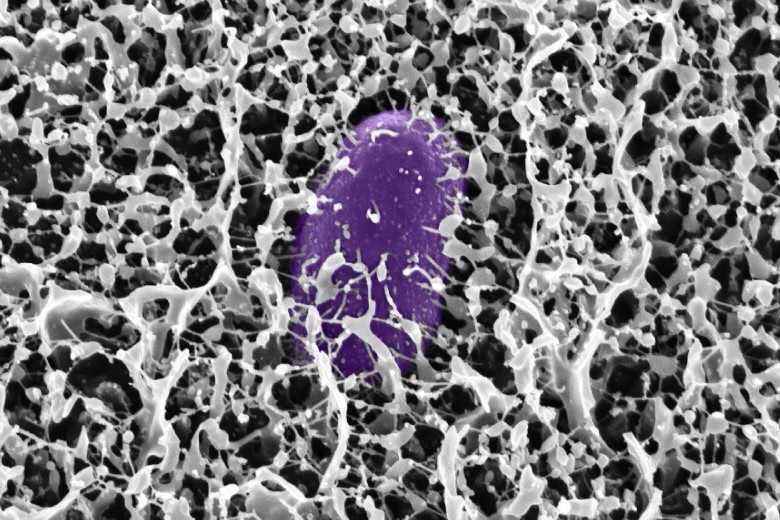Health
New Gene Therapy Approach Offers Precision in Treating Genetic Disorders
This innovation could pave the way for safer, more effective gene therapies for conditions like Fragile X syndrome and Friedreich’s ataxia.

Researchers at MIT have made a significant advancement in gene therapy, offering new hope for treating genetic diseases caused by a missing or defective gene. For years, scientists have pursued gene therapy as a potential cure for a range of monogenic diseases, where a single defective gene causes the disorder. However, the challenge has always been controlling how much of the therapeutic gene is expressed in target cells—too little expression means the therapy won’t work, while too much could result in harmful side effects.
In a study published in Cell Systems, MIT engineers have developed a system that delivers precise control over gene expression levels. Their method, called the ComMAND circuit (Compact microRNA-mediated Attenuator of Noise and Dosage), uses a novel feedback mechanism to regulate the amount of gene product produced in cells. This innovation could pave the way for safer, more effective gene therapies for conditions like Fragile X syndrome and Friedreich’s ataxia.
Led by MIT graduate student Kasey Love and senior author Katie Galloway, a professor in biomedical and chemical engineering, the research focuses on a special type of genetic control circuit known as an incoherent feedforward loop (IFFL). The circuit works by simultaneously activating both the target gene and a microRNA that suppresses the gene’s expression. This self-regulation helps keep gene expression at optimal levels—enough to be effective, but not so much as to cause toxicity.
“Gene supplementation can solve many monogenic disorders if we can control the therapy precisely,” explains Galloway. The team demonstrated this technique by targeting genes associated with Fragile X syndrome and Friedreich’s ataxia—both of which result in neurological and developmental issues. They successfully fine-tuned gene expression to levels that were eight times higher than normal, avoiding the excessive expression seen in earlier gene therapies that could have harmful consequences.
The key advantage of the ComMAND circuit is its compact design, which allows it to be delivered using common viral vectors like lentiviruses or adeno-associated viruses—the same delivery systems used in current gene therapy treatments. This simplicity improves the manufacturability and scalability of the therapy.
While the researchers have demonstrated success in human cells, they acknowledge that further tests in animal models are needed to fine-tune the system for clinical use. They hope this technology could eventually benefit patients with a range of genetic disorders, including muscular dystrophy, spinal muscular atrophy, and Rett syndrome.
“Despite the small patient populations for many of these rare diseases, we are working to develop tools that are robust enough for widespread use,” says Galloway, emphasizing the importance of such innovations in addressing diseases that often lack funding and research attention due to their rarity.
The breakthrough is a promising step toward making gene therapy not just a theoretical cure but a reliable, safe treatment option for genetic disorders, with potential applications that could transform the landscape of precision medicine in the years to come.
COP30
Health Systems ‘Unprepared’ as Climate Impacts Intensify, Experts Warn at COP30
India will require $643 billion between now and 2030 to adapt to climate change under a business-as-usual scenario

On Health Day at COP30 (November 13), global health and climate experts warned that the world is dangerously underprepared for the accelerating health impacts of climate change, calling for a dramatic scale-up of adaptation finance to protect vulnerable populations.
Speaking at a press conference hosted by Regions4, the Global Climate & Health Alliance and CarbonCopy, leaders from research institutions and national governments said climate-linked health threats — from extreme heat to wildfire smoke — are rising sharply while funding remains “colossally” insufficient.
“Each year, more than half a million lives are lost due to heat, and over 150,000 deaths are linked to wildfire smoke exposure,” said Dr. Marina Romanello, Executive Director of the Lancet Countdown. “Health systems, already stretched and underfunded, are struggling to cope with these growing pressures, and most are still unprepared for what is coming.”
Romanello added that despite the scale of the crisis, “only 44% of countries have costed their health adaptation needs, and existing finance falls short by billions. Without urgent investment, we will not be able to protect populations from escalating climate impacts.”
Adaptation gap continues to widen
The speakers described health-sector underfunding as a critical part of the broader adaptation finance gap. The latest UNEP Adaptation Gap Report estimates developing countries will need $310–365 billion annually by 2035, while the international community is still struggling to mobilise even the $40 billion Glasgow Pact Goal.
“With regards to finance, the reality is that we have a deficit that is quite colossal,” said Carlos Lopes, Special Envoy for Africa, COP30 Presidency. “Most of the efforts are from national authorities. What we need from international finance is that it must be complementary.”
Lopes cautioned that climate and health policy still operates in “multiple contested layers,” warning that unless these are aligned, “we risk losing coherence in our global response.”
Countries highlight urgent needs
Representatives from Bangladesh, Nigeria, India and Chile echoed concerns that adaptation finance is far from matching on-ground needs.
“Our adaptation financing for health is far below what is needed. The gap between what we require and what we receive is enormous,” said Md Ziaul Haque, Additional Director General, Ministry of Environment, Bangladesh. He urged multilateral finance entities to bring forward “concrete, holistic proposals that match the scale of the challenge.”
Nigeria’s challenges are equally stark. “In Nigeria, we are facing an additional 21% disease burden due to climate change… yet the adaptation finance we received in 2021–22 only met 6% of our needs,” said Oden Ewa, Commissioner for Special Duties and Green Economy Lead. He called adaptation finance a “lifeline that saves lives, strengthens communities, and protects economies.”
India outlines its adaptation burden
India also presented updated estimates of its climate adaptation needs. “India will require $643 billion between now and 2030 to adapt to climate change under a business-as-usual scenario,” said Dr. Vishwas Chitale of the Council for Energy, Environment & Water. He noted that India has already made “significant progress, spending $146 billion in 2021–2022 alone — 5.6% of GDP.”
New funding coalition signals momentum
Speakers highlighted the launch of the Climate and Health Funders Coalition, which has committed an initial $300 million annually.
“This is an encouraging signal… It shows that the world is beginning to recognise that protecting health must be at the centre of climate adaptation,” said Jeni Miller, Executive Director, Global Climate & Health Alliance.
Health at the centre of adaptation
Chile stressed the need for integrated policy approaches.
“It is vital to combine the efforts of different ministries — not only health but also transport, energy and food production — so that we generate co-benefits across sectors,” said Dr. Sandra Cortes, President of Chile’s Climate Change Scientific Committee. “A more integrated approach will allow us to improve public health, reduce emissions and create fairer, more sustainable development opportunities.”
As negotiators continue discussions in Belém, experts reiterated that adaptation finance — especially for health — must be just, equitable, accessible and prioritise the most climate-vulnerable nations. The recently proposed Belém Health Action Plan and the Global Goal on Adaptation are expected to serve as frameworks for strengthening health system resilience worldwide.
Health
Air Pollution Claimed 1.7 Million Indian Lives and 9.5% of GDP, Finds The Lancet
In 2022 alone, fine particulate pollution — PM2.5 — killed an estimated 1.7 million people in India, according to the Lancet Countdown on Health and Climate Change 2025.

In 2022 alone, fine particulate pollution — PM2.5 — killed an estimated 1.7 million people in India, according to the Lancet Countdown on Health and Climate Change 2025.
The same toxic particles that fill Delhi’s winter air and blanket cities from Kanpur to Kolkata also caused economic losses equivalent to 9.5% of India’s GDP, revealing that air pollution is not just a public health emergency, but a national economic crisis hiding in plain sight.
A Crisis Woven into Everyday Life
India’s worsening air quality is no longer a seasonal problem. According to The Lancet Countdown, over a third of Indians were exposed to PM2.5 levels exceeding World Health Organization (WHO) limits for more than 10 months of the year.
Rising temperatures, urban sprawl, and fossil fuel combustion — from coal-fired power plants to vehicle emissions — have created a deadly feedback loop that is choking the country’s lungs and its economy.
“Air pollution in India is a silent pandemic. It’s not only shortening lives, but undermining productivity, healthcare systems, and economic growth,” said Dr. Marina Romanello, Executive Director of The Lancet Countdown, in the report’s global launch statement.
The Health Toll: From Newborns to the Elderly
The Lancet Countdown 2025 estimates that the global death toll from air pollution reached 8.3 million in 2022, with India accounting for over one-fifth of those fatalities.
PM2.5 — particles less than 2.5 microns in diameter — penetrate deep into lungs and bloodstreams, causing or worsening heart disease, stroke, diabetes, and respiratory illness.
In India, the burden falls disproportionately on the poorest households, who are more likely to live near highways, coal plants, or industrial clusters and have limited access to healthcare.
Children and elderly people are the most vulnerable: the report highlights that exposure to dirty air increases the risk of low birth weight, premature births, and chronic illness later in life.
Counting the Cost: 9.5% of GDP Lost
The Lancet Countdown’s economic assessment, based on lost labour productivity, healthcare costs, and premature deaths, found that India lost 9.5% of its GDP in 2022 due to air pollution-related impacts.
That’s roughly equivalent to USD 300 billion — more than India’s entire annual education and health budgets combined.
Urban centres such as Delhi, Lucknow, and Patna rank among the most polluted in the world.
Air pollution is estimated to reduce life expectancy in northern India by up to 7 years, according to the Energy Policy Institute at the University of Chicago, underscoring how pervasive the damage has become.
“For a fast-growing economy like India, this is a double blow,” said Prof. Randeep Guleria, pulmonologist and former AIIMS director. “It burdens healthcare systems while reducing worker output — exactly the opposite of what a young nation needs.”
Climate and Air: The Same Enemy
The report connects India’s pollution crisis to its dependence on fossil fuels — especially coal — which remains the largest source of both CO₂ and PM2.5 emissions.
While government programmes such as the National Clean Air Programme (NCAP) and electric mobility initiatives aim to reduce pollution, progress has been slow.
Many of the dirtiest thermal plants continue to operate without meeting emission standards, and vehicle emissions remain poorly regulated outside major cities.
“Air pollution is not a separate problem from climate change — it’s the same story told through different symptoms,” noted Dr. Romanello. “Every tonne of coal burned harms both lungs and the climate.”
This linkage is echoed in India’s own National Electricity Plan 2032, which outlines aggressive renewable targets, and in Ember’s 2025 analysis, which found that expanding coal capacity further would be economically irrational — a finding that strengthens the case for rapid decarbonisation.
Health as an Economic Argument
The Lancet Countdown reframes pollution not just as an environmental or health challenge, but as an economic imperative.
In India, labour losses due to heat and pollution exposure have grown by 42% since the early 2000s, with outdoor and informal workers suffering the most.
As heatwaves and smog increasingly overlap, lost work hours and rising healthcare costs could slow GDP growth by up to 1.8 percentage points annually by the mid-2030s if left unchecked.
Experts say cleaner power and transport sectors could deliver rapid wins:
- Phasing out coal and shifting to renewables can cut PM2.5 emissions by over 60% in key industrial zones.
- Expanding public transit and EV adoption can reduce vehicular PM2.5 by one-third in metropolitan regions.
- Strengthening NCAP’s monitoring and enforcement could save hundreds of thousands of lives each year.
From Policy to Breathable Air
Despite India’s national clean air mission and renewable push, enforcement and coordination remain major gaps.
The report calls for integrating air quality and climate policies, arguing that cutting fossil fuel use provides a “double dividend” — cleaner air and fewer greenhouse gases.
This integration has begun in limited form: several Indian states, including Gujarat and Maharashtra, have introduced emissions trading schemes for industrial pollutants.
But experts say scaling such initiatives nationally, alongside stricter vehicle standards and urban planning reforms, is critical for measurable results.
A Moment of Reckoning
The Lancet Countdown 2025 warns that air pollution and climate impacts are already reversing health gains made over decades.
India’s choice is no longer between growth and clean air — it’s about whether growth can continue at all under the weight of rising illness, lost labour, and degraded ecosystems.
“Air pollution is robbing India of its demographic dividend,” the report concludes. “Clean air is not a luxury; it’s a prerequisite for sustainable development.”
As the smog season begins once again in northern India, the data are unambiguous:
The invisible killer is now visible — and unaffordable.
References:
The Lancet Countdown on Health and Climate Change 2025; The Lancet; Energy Policy Institute at the University of Chicago (EPIC); Ember; CREA.
Health
Study Unveils Mucus Molecules That Block Salmonella and Prevent Diarrhea
A new MIT-led study reveals how key mucus molecules naturally shield the gut from dangerous bacteria like Salmonella

A new MIT-led study reveals how key mucus molecules naturally shield the gut from dangerous bacteria like Salmonella. The breakthrough opens new pathways for affordable, preventative treatments for travelers and soldiers at risk of infection.
Researchers at MIT have discovered new powerful ways the body guards itself from dangerous bacteria: by deploying mucins, special molecules in mucus that neutralize microbes and stop infection before it starts. The team identified mucins—especially MUC2 and MUC5AC—in the digestive tract that shut down the genetic machinery Salmonella uses to invade cells and cause diarrhea.
“By using and reformatting this motif from the natural innate immune system, we hope to develop strategies to preventing diarrhea before it even starts. This approach could provide a low-cost solution to a major global health challenge that costs billions annually in lost productivity, health care expenses, and human suffering,” said Katharina Ribbeck, the Andrew and Erna Viterbi Professor of Biological Engineering at MIT, in a media statement.
In experiments, exposing Salmonella to the intestinal mucin MUC2 blocked the bacterial proteins that enable infection, turning off the critical regulator HilD. The study also found that a similar mucin from the stomach, MUC5AC, works the same way—and both molecules appear to protect against multiple foodborne germs triggered by similar genetic switches.
“We discovered that these mucins not only create a physical shield but also actively control whether pathogens can turn on genes needed for infection,” Ribbeck explained in the media statement.
Lead authors Kelsey Wheeler and Michaela Gold say synthetic versions of these mucins could soon be added to oral rehydration salts or chewable tablets, providing practical protection for troops, travelers, and people in high-risk areas. According to Wheeler, “Mucin mimics would particularly shine as preventatives, because that’s how the body evolved mucus — as part of this innate immune system to prevent infection,” she said.
-

 Know The Scientist6 months ago
Know The Scientist6 months agoRemembering S.N. Bose, the underrated maestro in quantum physics
-

 Society5 months ago
Society5 months agoShukla is now India’s first astronaut in decades to visit outer space
-

 Space & Physics4 months ago
Space & Physics4 months agoJoint NASA-ISRO radar satellite is the most powerful built to date
-

 Space & Physics4 months ago
Space & Physics4 months agoNew double-slit experiment proves Einstein’s predictions were off the mark
-

 The Sciences5 months ago
The Sciences5 months agoHow a Human-Inspired Algorithm Is Revolutionizing Machine Repair Models in the Wake of Global Disruptions
-

 Society6 months ago
Society6 months agoWhy the Arts Matter As Much As Science or Math
-

 Society6 months ago
Society6 months agoAxiom-4 will see an Indian astronaut depart for outer space after 41 years
-

 Earth6 months ago
Earth6 months agoWorld Environment Day 2025: “Beating plastic pollution”




























